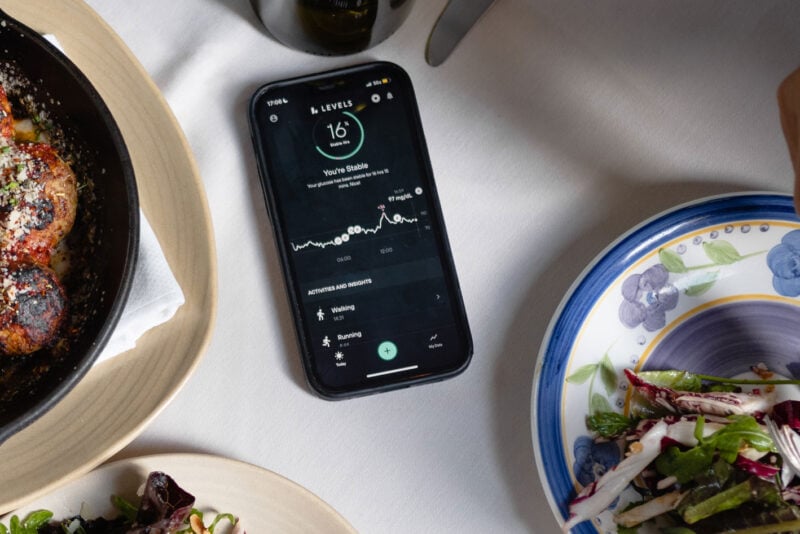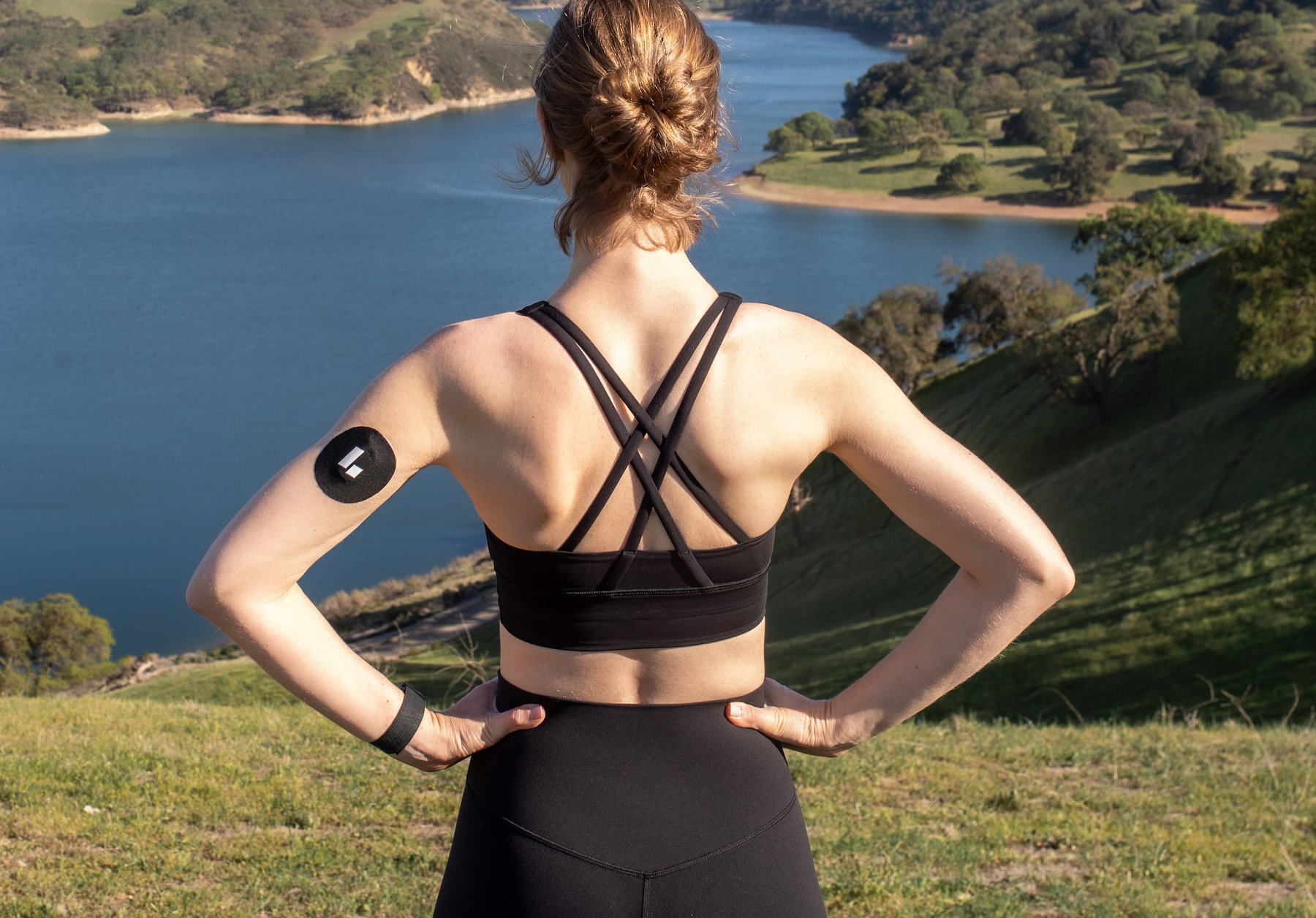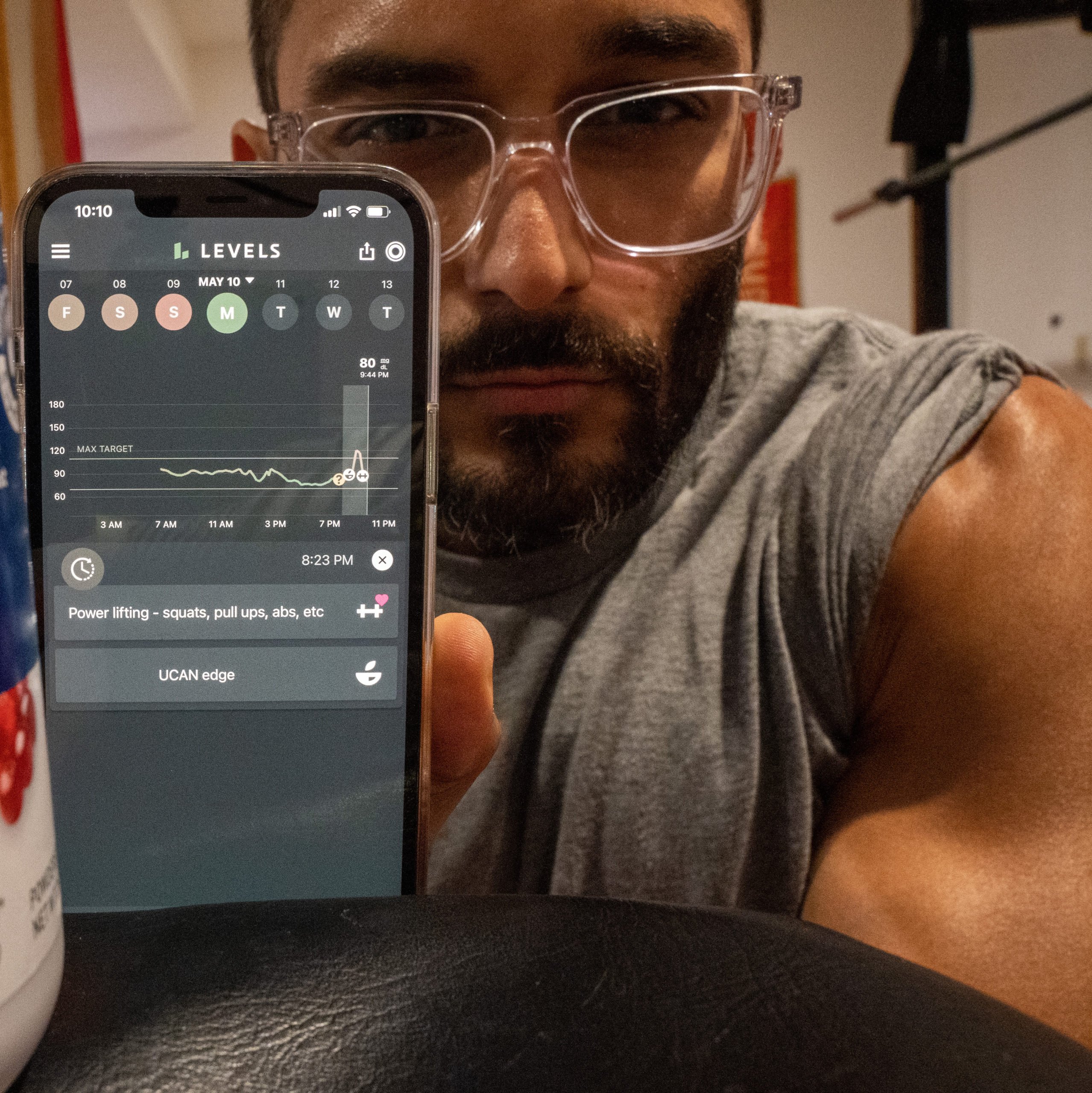In the modern world, we have wearable tools that give us detailed data on what’s happening in our bodies when we’re working out, stressing, sleeping, and more. We can get input on our heart rate with the click of a button. And yet, when it comes to food, we’ve never had real-time biofeedback to help us understand how our choices affect our bodies and how to optimize them. Instead, we’re stuck relying on our gut feelings—literally. Without feedback on nutrition and fasting, it’s harder to make personalized choices and stay accountable.
But it is now possible to get that same visibility on your diet, a clear window into precisely how your body responds to eating or fasting, thanks to continuous glucose monitors (CGMs). These wearable devices can uplevel your dietary choices and fasting regimens by showing you 24/7 real-time blood sugar levels in your body. They are especially powerful when paired with an app like Levels that helps you make sense of that biofeedback with meal tracking and long-term trends.
A CGM can provide helpful feedback before, during, and after a fast in several ways:
- It can keep you accountable and help you feel empowered as you watch your blood glucose levels slowly decline and then hold steady during a fast.
- Wearing a CGM can be reassuring, showing that while you may be hungry initially in your fast, your glucose levels are likely still in a safe range.
- A glucose monitor can help you shape your diet and establish a healthy baseline before you start fasting so that you build metabolic flexibility over time and start adapting to using fat for energy before you jump fully into fasting.
- If you consume some foods or drinks, such as broth, during your fast, you can know precisely how they affect your mean glucose levels and avoid any that spike your glucose and impair fasting progress.
A CGM empowers you to make highly tuned feeding choices that can help you feel better throughout your fast and could amp up the positive effects of fasting. It’s Fasting 2.0.
The Metabolic Machinery of Fasting
A quick primer on what’s happening in your body when you fast will help illustrate why tracking glucose is so important.
The two primary sources of fuel for your cells are glucose (usually delivered through carbohydrates you eat) and fat, which is stored and later converted to fuel in the form of ketones. After a typical meal, when glucose concentrations in your blood rise, the pancreas releases insulin, which tells the cells to take up that extra glucose as fuel. The rest gets stored in the liver as glycogen or converted to fat.
During a fast, your body first consumes circulating glucose and stored glycogen. As that fuel source depletes, your body turns to burning fat to make ketones. Several studies show that using ketones for energy benefits muscle development, cell and organ function, and even brain health. That ability to switch between fuel sources is called metabolic flexibility, and it’s something you can train your body to do more efficiently and is associated with longevity (PDF). (Going on a keto diet, in which very few carbohydrates are consumed, can also aid the body in switching to fat-burning mode.)
Too much glucose—either from frequent eating or from loading up on carb-heavy foods during your feeding period—interferes with this process in two ways. First, if we give the body lots of energy in the form of glucose, the body will use that first and not need to make the metabolic switch to burning fat to produce ketones. Second, high glucose (hyperglycemia) leads to increased insulin, which prevents our bodies from burning fat. High insulin makes it very difficult to be metabolically flexible and makes us more reliant on glucose for energy. Chronically high insulin can also lead to insulin resistance, a condition associated with metabolic dysfunction, obesity, and Type 2 diabetes.
Fasting benefits our bodies by allowing us to burn through our stored glucose, minimize insulin spikes by avoiding dietary carbohydrates, improve insulin sensitivity, and nudge our bodies toward a fat-burning state. A CGM can give us a lens into how our bodies are responding to a fast and moving through our glucose. And while a CGM provides that real-time feedback, many people beginning a fasting regimen like to get a blood test before and after the fasting protocol, to assess how, if at all, it impacted certain biomarkers such as triglycerides and HbA1c.

The benefits of fasting for metabolic health
Here’s how shrinking the number of hours you spend eating can help stabilize glucose levels and improve your overall health
Read the ArticleCGM & Fasting: Four Ways That Glucose Data Makes Fasting Easier
1. Accountability: Stick With It!
Seeing the effect fasting has on your glucose levels can be an effective motivator and reminder of how your actions are helping your body. You can watch as your glucose stays steady and likely declines throughout the fast as your body burns through your circulating and stored glucose. (The steadier your glucose levels—and the lower your glycemic variability—the better.) If you’re on a short fast (say, 16 hours overnight), you might find that your fasting glucose is lower the morning after than on days when you eat later into the evening. On a longer fast (e.g., 24-72 hours), glucose may slowly trend down over time and then be rock-solid stable. Seeing your glucose trends in real-time on a graph on your smartphone can be empowering, knowing that if you break your fast, you’ll immediately notice the feedback of a spike.
Levels Member Experience:
2. Reassurance: You’re Doing Great!
It’s common to feel less than 100 percent when you first start fasting. Your body is learning to make that metabolic switch from glucose to fat, and like any kind of training, it becomes easier only as you build those adaptations over time. When you first experience hunger or fatigue during a fast, it’s natural to wonder if your body has enough fuel—some people may even wonder if they have slipped into hypoglycemia, meaning their blood sugar is too low. Seeing in real time that your glucose levels are still in a healthy range can reassure us that hunger is not always the same as hypoglycemia, which can give us the confidence to push through. (Of course, it’s always best practice to consult your healthcare provider before starting a fast, especially a long-duration one.)
3. Adaptation: Prepare Your Body to Be Flexible
The higher our glucose, and by proxy insulin, are going into a fast, the more challenging it may feel, as elevated insulin makes it harder for our bodies to make that switch to burning fat. But just as athletes train to feel their best during the all-out effort of a race, you can prepare your body for fasting by using CGM to tailor your diet to one that keeps your glucose levels in a healthy range before you fast.
There’s no one-size-fits-all plan for a metabolically healthy diet and lifestyle: research shows two people can have very different glucose responses to the same carbohydrate intake. Over time, feedback from a CGM can help you refine your daily decisions around diet and lifestyle to help your body learn to live with improved glycemic control, where it’s in a more stable glucose state (with less glucose variability) and can more easily make that switch to fat burning.
4. Avoiding Pitfalls: Watch Out For Spikes
Knowing how our individual bodies respond to different foods can also help us avoid glucose spikes during a fast or when breaking a fast. For instance, many people use broth or other beverages to help get through longer fasts, and while this may be a good strategy, it’s helpful to know that these fasting adjuncts aren’t thwarting your progress by spiking your glucose levels and knocking your body out of fat-burning mode. (Again, for extended fasts, it’s best to seek medical advice from a healthcare professional.) Spending time with a CGM can help you hone in on foods you can use during and after a fast and which ones to avoid so you remain within your desired metrics.
Next-Level Fasting
Fasting can encourage healthy changes in your body and hone your metabolic flexibility and improve glucose control. Adding real-time nutritional feedback from a CGM can make fasting easier and more effective by giving you continuous dietary and lifestyle feedback, so you can leverage your personalized data to learn how to help your body become more metabolically healthy.
Learn more:











